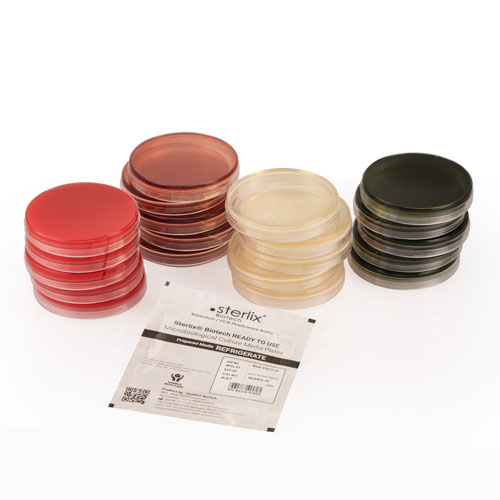STERLIX® Nutrient Ready To Use Agar Plate
Product Details
Nutrient agar plate, also known as general-purpose agar, is a basic and versatile culture medium used in microbiology laboratories. It provides a nutrient-rich environment that supports the growth of a wide variety of microorganisms, including bacteria, yeasts, and molds.
The composition of nutrient agar typically includes the following key components:
Peptone: A mixture of partially digested proteins that serves as a nitrogen source for bacterial growth.
Beef extract: A water-soluble extract derived from beef tissue, containing a variety of nutrients such as vitamins, minerals, and organic compounds.
Agar: A polysaccharide obtained from marine algae that solidifies the medium, providing a surface for microbial colony formation.
Water: Provides a solvent for the other components and helps maintain the proper consistency of the agar medium.
Nutrient agar plates are widely used for several purposes in microbiology, including:
General Culturing: Nutrient agar supports the growth of a broad range of microorganisms, making it suitable for routine cultivation and maintenance of laboratory cultures.
Enumeration: Nutrient agar plates can be used for counting the number of viable microorganisms in a given sample, providing information about the microbial load or population density.
Isolation: Nutrient agar plates can be used to isolate and separate individual microbial colonies from a mixed population. Streaking or serial dilution techniques are commonly employed for this purpose.
Colony Morphology: Nutrient agar allows for the observation of colony morphology, which can aid in the initial identification of microorganisms based on their size, shape, color, texture, or other visible characteristics.
Nutrient agar plates are considered non-selective, meaning they support the growth of a wide range of microorganisms without inhibiting any particular group. This makes nutrient agar a versatile medium for general laboratory use. However, it's important to note that for specific purposes, such as the isolation of specific organisms or the differentiation of particular bacterial types, specialized selective and differential media may be more appropriate.
The composition of nutrient agar typically includes the following key components:
Peptone: A mixture of partially digested proteins that serves as a nitrogen source for bacterial growth.
Beef extract: A water-soluble extract derived from beef tissue, containing a variety of nutrients such as vitamins, minerals, and organic compounds.
Agar: A polysaccharide obtained from marine algae that solidifies the medium, providing a surface for microbial colony formation.
Water: Provides a solvent for the other components and helps maintain the proper consistency of the agar medium.
Nutrient agar plates are widely used for several purposes in microbiology, including:
General Culturing: Nutrient agar supports the growth of a broad range of microorganisms, making it suitable for routine cultivation and maintenance of laboratory cultures.
Enumeration: Nutrient agar plates can be used for counting the number of viable microorganisms in a given sample, providing information about the microbial load or population density.
Isolation: Nutrient agar plates can be used to isolate and separate individual microbial colonies from a mixed population. Streaking or serial dilution techniques are commonly employed for this purpose.
Colony Morphology: Nutrient agar allows for the observation of colony morphology, which can aid in the initial identification of microorganisms based on their size, shape, color, texture, or other visible characteristics.
Nutrient agar plates are considered non-selective, meaning they support the growth of a wide range of microorganisms without inhibiting any particular group. This makes nutrient agar a versatile medium for general laboratory use. However, it's important to note that for specific purposes, such as the isolation of specific organisms or the differentiation of particular bacterial types, specialized selective and differential media may be more appropriate.

